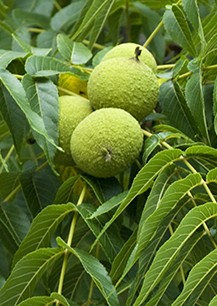 A native of eastern and central North American from New England through Texas, black walnut is a tall, deciduous tree with a straight trunk bare of branches for 20 to 30 feet. The pinnately compound leaves, are dark green, aromatic, 1-2’ long and consist of up to 23 leaflets. They are late to appear in spring and drop early in the fall after changing yellow. Male and female flowers are produced on the same tree. The male flowers are small, scaly, pendulous catkins while the female flowers are on short terminal spikes. Green, almost spherical fruits develop from female flowers and gradually turn black after they fall from the tree. Mature trees can produce a huge quantity of fruits that can be very messy and create problems. The outer cases of the fruit stain anything they touch so concrete walks or evergreen ground-cover under the tree may be unsightly. Deciduous shrubs or herbaceous plants are better choices for understory vegetation. The fruits are harvested for their food value although the inner cases of the fruits are exceptionally hard making it difficult to obtain the flesh. The bark of the tree is gray-black, fissured, and exhibits a diamond pattern. Black walnuts are hard to transplant because of an extensive taproot. Their roots also exude a substance that inhibits the growth of certain plants such as azaleas, rhododendrons, members of the rose family, peonies, tomatoes, eggplants, and peppers. The wood of black walnut is valued for items as furniture and cabinets.
A native of eastern and central North American from New England through Texas, black walnut is a tall, deciduous tree with a straight trunk bare of branches for 20 to 30 feet. The pinnately compound leaves, are dark green, aromatic, 1-2’ long and consist of up to 23 leaflets. They are late to appear in spring and drop early in the fall after changing yellow. Male and female flowers are produced on the same tree. The male flowers are small, scaly, pendulous catkins while the female flowers are on short terminal spikes. Green, almost spherical fruits develop from female flowers and gradually turn black after they fall from the tree. Mature trees can produce a huge quantity of fruits that can be very messy and create problems. The outer cases of the fruit stain anything they touch so concrete walks or evergreen ground-cover under the tree may be unsightly. Deciduous shrubs or herbaceous plants are better choices for understory vegetation. The fruits are harvested for their food value although the inner cases of the fruits are exceptionally hard making it difficult to obtain the flesh. The bark of the tree is gray-black, fissured, and exhibits a diamond pattern. Black walnuts are hard to transplant because of an extensive taproot. Their roots also exude a substance that inhibits the growth of certain plants such as azaleas, rhododendrons, members of the rose family, peonies, tomatoes, eggplants, and peppers. The wood of black walnut is valued for items as furniture and cabinets.
Type: Deciduous tree
Outstanding Features: Wood for furniture
Form: Broad, round, dense canopy
Growth Rate: Rapid at first; moderate with maturity
Bloom: Flowers appear in late spring; not ornamental.
Size: 60-70’ H x 50-70’ W
Light: Full sun
Soil: Organically rich, moist, well-drained
Hardiness: Zones 4-9
Care: Fruits messy and create problems.
Pests and Diseases: Webworm, various caterpillars, scales, aphids, mites, anthracnose, leaf spot, canker, bacterial blight, powdery mildew.
Propagation: Seed.
